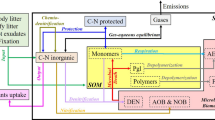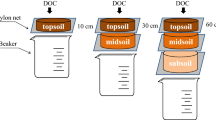Abstract
The DyDOC model was used to simulate the soil carbon cycle of a deciduous forest at the Oak Ridge Reservation (Tennessee, USA). The model application relied on extensive data from the Enriched Background Isotope Study (EBIS), which exploited a short-term local atmospheric enrichment of radiocarbon to establish a large-scale manipulation experiment with different inputs of 14C from both above-ground and below-ground litter. The model was first fitted to hydrological data, then observed pools and fluxes of carbon and 14C data were used to fit parameters describing metabolic transformations of soil organic matter (SOM) components and the transport and sorption of dissolved organic matter (DOM). This produced a detailed quantitative description of soil C cycling in the three horizons (O, A, B) of the soil profile. According to the parameterised model, SOM turnover within the thin O-horizon rapidly produces DOM (46 gC m−2 a−1), which is predominantly hydrophobic. This DOM is nearly all adsorbed in the A- and B-horizons, and while most is mineralised relatively quickly, 11 gC m−2 a−1 undergoes a “maturing” reaction, producing mineral-associated stable SOM pools with mean residence times of 100–200 years. Only a small flux (~1 gC m−2 a−1) of hydrophilic DOM leaves the B-horizon. The SOM not associated with mineral matter is assumed to be derived from root litter, and turns over quite quickly (mean residence time 20–30 years). Although DyDOC was successfully fitted to C pools, annual fluxes and 14C data, it accounted less well for short-term variations in DOC concentrations.









Similar content being viewed by others
References
Amundson R (2001) The carbon budget in soils. Annu Rev Earth Planet Sci 29:535–562
Baisden WT, Parfitt RL (2007) Bomb 14C enrichment indicates decadal C pool in deep soil? Biogeochemistry 85:59–68
Buurman P, Jongmans AG (2005) Podzolisation and soil organic matter dynamics. Geoderma 125:71–83
Cisneros-Dozal LM, Trumbore S, Hanson PJ (2006) Partitioning sources of soil-respired CO2 and their seasonal variation using a unique radiocarbon tracer. Glob Change Biol 12:194–204
Fröberg M, Berggren D, Bergkvist B, Bryant C, Knicker H (2003) Contributions of Oi, Oe and Oa horizons to dissolved organic matter in forest floor leachates. Geoderma 113:311–322
Fröberg M, Jardine PM, Hanson PJ, Swanston CW, Todd DE, Tarver JR, Garten CT (2007a) Low dissolved organic carbon input from fresh litter to deep mineral soils. Soil Sci Soc Am J 71:347–354
Fröberg M, Berggren Kleja D, Hagedorn F (2007b) The contribution of fresh litter to dissolved organic carbon leached from a coniferous forest floor. Eur J Soil Sci 58:108–114
Fröberg M, Hanson PJ, Trumbore SE, Swanston CW, Todd DE (2009) Flux of carbon from 14C-enriched leaf litter throughout a forest soil mesocosm. Geoderma 149:181–188
Gaudinski JB, Trumbore SE (2003) Soil carbon turnover. In: Hanson PJ, Wullschleger SD (eds) North American temperate deciduous forest responses to changing precipitation regimes. Springer, New York
Gaudinski JB, Torn MS, Riley WJ, Swanston C, Trumbore SE, Joslin JD, Majdi H, Dawson TE, Hanson PJ (2009) Use of stored carbon reserves in growth of temperate tree roots and leaf buds: analyses using radiocarbon measurements and modelling. Global Change Biol 15:992–1014
Golchin A, Oades JM, Skjemstad J, Clarke P (1994) Soil structure and carbon cycling. Aust J Soil Res 32:1043–1068
Gu L, Hanson PJ, Post WM, Liu Q (2008) A novel approach for identifying the true temperature sensitivity from soil respiration measurements. Glob Biogeochem Cycles 22:GB4009. doi:10.1029/2007GB003164
Guggenberger G, Zech W (1992) Retention of dissolved organic carbon and sulfate in aggregated forest soils. J Environ Qual 21:643–653
Hagedorn F, Saurer M, Blaser P (2004) A C-13 tracer study to identify the origin of dissolved organic carbon in forested mineral soils. Eur J Soil Sci 55:91–100
Hanson PJ, Wullschleger SD (eds) (2003) North American temperate deciduous forest responses to changing precipitation regimes. Ecological studies, vol 166. Springer, New York, 472 pp
Hanson PJ, Swanston CW, Garten CT, Todd DE, Trumbore SE (2005) Reconciling change in Oi-horizon carbon-14 with mass loss for an oak forest. Soil Sci Soc Am J 69:1492–1502
Jardine PM, Wilson GV, Luxmoore RJ (1988) Modeling the transport of inorganic ions through undisturbed soil columns from two contrasting watersheds. Soil Sci Soc Am J 52:1252–1259
Jardine PM, Weber NL, McCarthy. JF (1989) Mechanisms of dissolved organic carbon adsorption by soil. Soil Sci Soc Am J 53:1378–1385
Jardine PM, Wilson GV, McCarthy JF, Luxmoore RJ, Taylor DL (1990) Hydrogeochemical processes controlling the transport of dissolved organic carbon through a forested hillslope. J. Contam Hydrol 6:3–19
Jardine PM, Mayes MA, Mulholland PJ, Hanson PJ, Tarver JR, Luxmoore RJ, McCarthy JF, Wilson GV (2006) Vadose zone flow and transport of dissolved organic carbon at multiple scales in humid regimes. Vadose Zone J 5:140–152
Jenkinson DS (1990) The turnover of organic carbon and nitrogen in soil. Philos Trans R Soc B 329:361–368
Jenkinson DS, Coleman K (2008) The turnover of organic carbon in subsoils. Part 2. Modelling carbon turnover. Eur J Soil Sci 59:400–413
Johnson DW, Van Hook RI (eds) (1989) Analysis of biogeochemical cycling processes in Walker Branch Watershed. Springer, New York
Joslin JD, Wolfe MH (2003) Fine root growth response. In: Hanson PJ, Wullschleger SD (eds) North American temperate deciduous forest responses to changing precipitation regimes. Ecological studies, vol 166. Springer, New York, pp 274–302
Joslin JD, Gaudinski JB, Torn MS, Riley WJ, Hanson PJ (2006) Fine-root turnover patterns and their relationship to root diameter and soil depth in a C-14-labelled hardwood forest. New Phytol 172:523–535
Kaiser K, Zech W (1997) Competitive sorption of dissolved organic matter fractions to soils and related mineral phases. Soil Sci Soc Am J 61:64–69
Kalbitz K, Kaiser K (2008) Contribution of dissolved organic matter to carbon storage in forest mineral soils. J Plant Nutr Soil Sci 171:52–60
Kalbitz K, Schwesig D, Rethemeyer J, Matzner E (2005) Stabilization of dissolved organic matter by sorption to the mineral soil. Soil Biol Biochem 37:1319–1331
Kalbitz K, Meyer A, Yang R, Gestberger P (2007) Response of dissolved organic matter in the forest floor to long-term manipulation of litter and throughfall inputs. Biogeochemistry 86:301–318
Luxmoore RJ, Huff DD (1989) Water. In: Johnson DW, Van Hook RI (eds) Analysis of biogeochemical cycling processes in walker branch watershed. Springer, New York
Michalzik B, Tipping E, Mulder J, Gallardo Lancho JF, Matzner E, Bryant CL, Clarke N, Lofts S, Vicente Esteban MA (2003) Modelling the production and transport of dissolved organic carbon in forest soils. Biogeochemistry 66:241–264
Mikutta R, Kleber M, Torn MS, Jahn R (2006) Stabilization of soil organic matter: association with minerals or chemical recalcitrance? Biogeochemistry 77:25–56
Neff JC, Asner GP (2001) Dissolved organic carbon in terrestrial ecosystems: synthesis and a model. Ecosystems 4:29–48
Parton WJ, Schimel DS, Cole CV, Ojima DS (1987) Analysis of factors controlling soil organic levels of grasslands in the Great Plains. Soil Sci Soc Am J 51:1173–1179
Parton WJ, Hartman M, Ojima D, Schimel D (1998) DAYCENT and its land surface submodel: description and testing. Glob Planet Change 19:35–48
Qualls RG, Haines BL (1991) Geochemistry of dissolved organic nutrients in water percolating through a forest ecosystem. Soil Sci Soc Am J 55:1112–1123
Qualls RG, Haines BL (1992) Biodegradability of dissolved organic nutrients in forest throughfall, soil solution, and stream water. Soil Sci Soc Am J 56:578–586
Riley WJ, Gaudinski JB, Torn MS, Joslin JD, Hanson PJ (2009) Fine-root mortality rates in a temperate forest: estimates using radiocarbon data and numerical modelling. New Phytol 184:387–398
Rumpel C, Eusterhues K, Kögel-Knabner I (2004) Location and chemical composition of stabilized organic carbon in topsoil and subsoil horizons of two acid forest soils. Soil Biol Biochem 36:177–190
Sanderman J, Amundson R (2009) A comparative study of dissolved organic carbon transport and stabilization in California forest and grassland soils. Biogeochemistry 92:41–59
Shindo H, Huang PM (1982) Role of Mn(IV) oxide in abiotic formation of humic substances in the environment. Nature 298:363–365
Swanston CW, Torn MS, Hanson PJ, Southon JR, Garten CT, Hanlon EM, Ganio L (2005) Initial characterization of processes of soil carbon stabilization using forest stand-level radiocarbon enrichment. Geoderma 128:52–62
Tipping E, Fröberg M, Berggren D, Mulder J, Bergqvist B (2005) DOC leaching from a coniferous forest floor: modelling a manipulation experiment. J Plant Nutr Soil Sci 168:316–324
Tipping E, Smith EJ, Bryant CL, Adamson JK (2007) The organic carbon dynamics of a moorland catchment in N.W. England. Biogeochemistry 84:171–189
Treseder KK, Torn MS, Masiello CA (2006) An ecosystem-scale radiocarbon tracer to test use of litter carbon by ectomycorrhizal fungi. Soil Biol Biochem 38:1077–1082
Trumbore SE (2000) Age of soil organic matter and soil respiration: radiocarbon constraints on belowground C dynamics. Ecol Appl 10:399–411
Trumbore SE (2009) Radiocarbon and soil dynamics. Annu Rev Earth Planet Sci 37:47–66
Trumbore SE, Gaudinski JB, Hanson PJ, Southon JR (2002) Quantifying ecosystem-atmosphere carbon exchange with a 14C label. EOS 83(265):267–268
Vogel JS, Southon JR, Nelson DE, Brown TA (1984) Performance of catalytically condensed carbon for use in accelerator mass-spectrometry. Nucl Instrum Methods Phys Res B 5:289–293
Wilson GV, Luxmoore RJ (1988) Infiltration, macroporosity, and mesoporosity distributions in two forested watersheds. Soil Sci Soc J Am 52:329–335
Wilson GV, Jardine PM, O’Dell JD, Collineau M (1993) Field-scale transport from a buried line source in unsaturated soil. J Hydrol 145:83–109
Acknowledgments
The authors appreciate the EBIS field data collections effort of Donald E. Todd Jr., and detailed and time consuming 14C-analyses of Chris Swanston that made this paper possible. The work of E. Tipping and P.M. Chamberlain was supported by grant NE/D00697 from the UK Natural Environment Research Council. Associated support for the EBIS project for the efforts of M. Fröberg, P. J. Hanson and P. M. Jardine was provided by the U.S. Department of Energy, Office of Science, Biological and Environmental Research. Oak Ridge National Laboratory is managed by UT-Battelle, LLC for the U.S. Department of Energy under Contract No. DE-AC05-00OR22725. We are grateful to three anonymous referees for their constructive criticisms of the original submission, attention to which substantially improved the paper.
Author information
Authors and Affiliations
Corresponding author
Electronic supplementary material
Below is the link to the electronic supplementary material.
Rights and permissions
About this article
Cite this article
Tipping, E., Chamberlain, P.M., Fröberg, M. et al. Simulation of carbon cycling, including dissolved organic carbon transport, in forest soil locally enriched with 14C. Biogeochemistry 108, 91–107 (2012). https://doi.org/10.1007/s10533-011-9575-1
Received:
Accepted:
Published:
Issue Date:
DOI: https://doi.org/10.1007/s10533-011-9575-1




